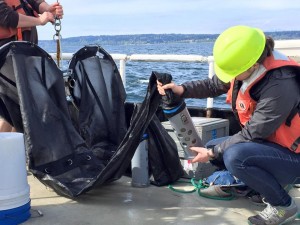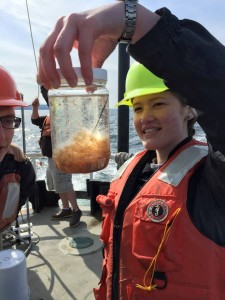Creating partnerships to conserve the marine environment

Mariko Kobayashi
Major: Environmental Studies
Minor: Marine biology and oceanography
Hometown: Carlsbad, CA
Do you recall your first experience with nature?
As a kid, I was always exposed to the marine environment. I lived by the beach and went on diving trips to get crabs and examine sea kelp. My school took us on field trips via the Scripps Aquarium and I grew up fascinated with marine life.
Why did you choose the Environmental Studies major?
I’ve always been interested in how humans interact with the environment. I took ENVIR 100 (Introduction to Environmental Studies) with Kristi Straus and realized I wanted a more interdisciplinary path. I saw alignment with Kristi’s own varied professional path. The Environmental Studies major offered a lot more opportunity for me to grow as an individual and have broader knowledge of the environment, including the social (human) side.
What’s the most influential moment/class you’ve experienced in this major?
In ENVIR 250: Research Methods in Environmental Studies, Tim (Billo) and Yen-Chu (Weng) took us on a field trip to Ravenna Park where we did some water and invertebrate sampling; I was surprised to find leeches and all other forms of life. It was really valuable to see how much of an influence communities had on these creatures as a result of their run-off into the streams.

In what ways are you sharing your passion and knowledge with UW and the community?
I co-founded the UW marine biology club and our goal is to build a community of students who are passionate about marine science. We organize tide pooling trips, social events, volunteer work, academic seminars and more. Anyone associated with the UW is welcome to join!
I am also the student rep for the College of the Environment Curriculum Committee. Outside of university life, I volunteer at the Seattle Aquarium as a science interpreter for kids.
What project are you currently working on?
As part of my Environmental Studies Capstone project, I will be working with founders of the Marine Resources Advisory Council, including Washington Sea Grant, The Nature Conservancy and the EPA to create partnerships for ocean acidification.
In this role I need to think about ocean acidification and how it ripples through different organizations and ask: how can different organizations partner on these issues? I’m excited about working collaboratively on a matrix of target audiences for ocean acidification issues, and will seek outside organizations (NGOs) who aren’t currently addressing these issues and then conduct outreach and education to help enlist their support.

Why is ocean acidification so relevant?
To me, ocean acidification and its effect on sea critters is the canary in the coalmine; it’s a consequence of climate change and human impact. As a result, it affects corals and shellfish, as well as tiny organisms at the base of the food chain, like pteropods (the most adorable sea snails out there!). Ocean acidification lets us know that our primary producers are in danger. That affects the entire ecosystem.
So, pteropods?
I took an oceanography class where I had the amazing experience of going on an ocean cruise (the first of three I would take) through NANOOS (Northwest Association of Networked Ocean Observing Systems). I met Dr. Jan Newton (executive director of NANOOS) at the start of my sophomore year and then learned about the cruises through her. We conducted research and collected phytoplankton and pteropods and I learned how important they are to the marine food web.
What are your plans after graduation?
I’m interested in joining the Peace Corps, or NOAA Corps, which focuses more on marine affairs in the Pacific Northwest.
What advice would you give to current and prospective students?
Take lots of different classes! Get to know faculty, develop relationships early. They are so nice! And some amazing opportunities arise from interacting with faculty and peers.
Mariko graduated in Spring 2016.